The European Union’s passportless Schengen area is spending its 35th anniversary effectively suspended and locked down, with temporary restrictions and border controls erected between its member countries because of the coronavirus pandemic.
The border-free zone, named after the eponymous Luxembourg village where the agreement was signed, first came into effect on 26 March 1995 including just five countries: France, Germany, Belgium, Luxembourg, and Netherlands. They agreed to remove passport controls between each other, simplifying travel for millions of people.
The zone rapidly grew to formally encompass 26 European states both inside and outside the Union. It stretches from Iceland and Norway in the north, to Portugal in the west and runs practically interrupted through to Poland, Finland and Estonia’s eastern borders.
Download the new Independent Premium app
Sharing the full story, not just the headlines
Other recent EU member states like Croatia, Bulgaria and Romania want to join but have not yet met the conditions to do so: only the UK, and Ireland with its common travel area with Britain, have remained permanently outside.
But the borderless vision has been temporarily suspended during the Covid-19 outbreak. Under the agreement, countries can, with notification, temporarily reimpose border checks. 14 states have so far notified the European Commission about their checks – though other countries have reportedly been imposing them informally, too.
The public health emergency is not the first time in recent memory that borders have sprung back up and the system has been tested: the refugee crisis in 2015 saw checks imposed by several countries.
At the height of the crisis, migration commissioner Dimitris Avramopoulos warned that the area’s future was in jeopardy, and that it could endanger the entire process of integration.
“If Schengen collapses, it will be the beginning of the end of the European project,” the Commissioner told MEPs in January 2016.
This time, the Commission has not issued such a stark warning. But long traffic jams of lorries began to form at various EU crossing last week: the longest of which was on the A4 highway between Germany and Poland, where traffic backed up for 37 miles.
It was this sight that prompted European Commission president Ursula von der Leyen to launch an EU-wide travel ban for those arriving in Europe officials said. The hope was that closing the bloc’s external borders would “enable the lifting of internal border control measures, which several member state have recently reintroduced in an effort to limit the spread of the virus”.


1/50 24 March 2020
Staff members line up to attention as they prepare to spray disinfectant at Wuhan Railway Station. China announced that a lockdown would be lifted on more than 50 million people in central Hubei province where the Covid-19 coronavirus first emerged late last year
AFP via Getty

2/50 23 March 2020
A public order agency officer sprays disinfectant over a woman before she enters a local government office as a precautionary move against the spread of the Covid-19 coronavirus in Surabaya
AFP via Getty

3/50 22 March 2020
Boys wearing protective and N95 masks play with a football outside their homes in Gaza City
AFP via Getty

4/50 21 March 2020
A woman standing on her balcony reaches out to catch a rose delivered to her via a drone on Mother’s day, in the Lebanese coastal city of Jounieh, north of the capital Beirut, as people remain indoors in an effort to limit the spread of coronavirus. In a quiet Lebanese town under lockdown over the novel coronavirus, a drone buzzed towards a balcony on Saturday to deliver a red rose to a mother grinning in surprise. The COVID-19 pandemic may have put a damper on Mother’s Day this year, but three students have come up with a novel service to celebrate the occasion without flouting social distancing restrictions
AFP via Getty

5/50 20 March 2020
Newlyweds Diego Fernandes, 46 and Deni Salgado, 30, kiss through protective face masks at a wedding ceremony with only witnesses and no guests, as public gatherings are banned as part of Italy’s lockdown measures to prevent the spread of coronavirus disease in Naples
Reuters

6/50 19 March 2020
Members of a medical assistance team from Jiangsu province chant slogans at a ceremony marking their departure after helping with the Covid-19 coronavirus recovery effort, in Wuhan. Medical teams from across China began leaving Wuhan this week after the number of new coronavirus infections dropped. China on reported no new domestic cases for the first time since it started recording them in January, but recorded a spike in infections from abroad
AFP via Getty

7/50 18 March 2020
Sri Lankan police wear face masks a rehearsal parade in Colombo
AFP via Getty

8/50 17 March 2020
Divers clean and swipe the floor and walls of a pool at an aquatic complex in Medellin after the closure of all sporting venues in Colombia as a preventive measure against the spread of the Covid-19
AFP via Getty

9/50 16 March 2020
Workers spray disinfectant as a precaution against the spread of coronavirus at the Mubarikiya market following the outbreak of coronavirus, in Kuwait City
EPA

10/50 15 March 2020
People gather with their belongings at the scene of the fire outbreak at Abule-Ado in Lagos, Nigeria
Reuters

11/50 14 March 2020
A man feeds pidgeons at Cataluna Square in Barcelona
EPA
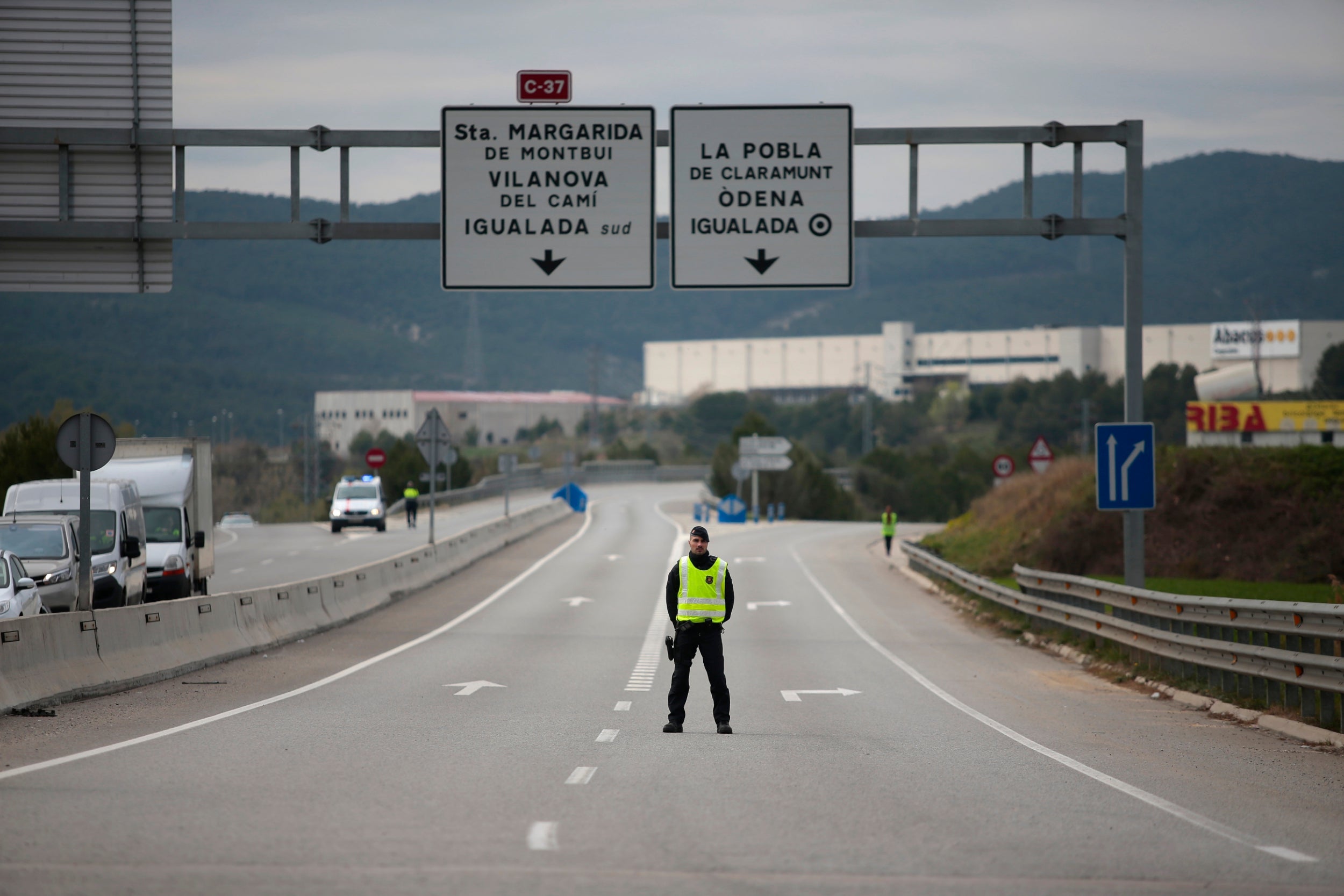
12/50 13 March 2020
A mosso de esquadra police officer stands on the closed off road near Igualada, Spain. Over 60,000 people awoke Friday in four towns near Barcelona confined to their homes and with police blocking roads. The order by regional authorities in Catalonia is Spain’s first mandatory lockdown as Covid-19 coronavirus infections increase sharply
AP
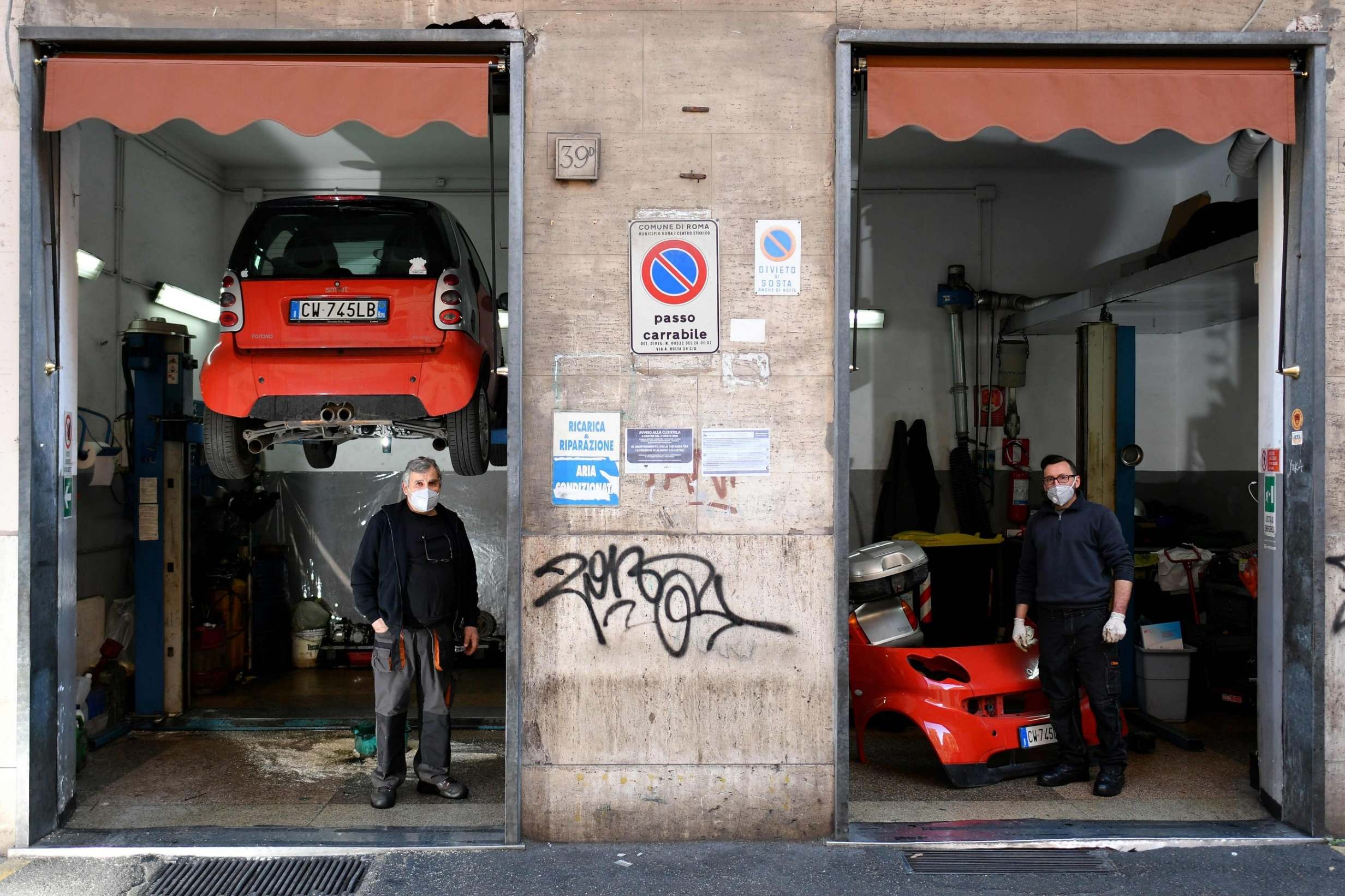
13/50 12 March 2020
Italian mechanics Giacomo and Alessandro pose at their garage in Rome, as Italy shut all stores except for pharmacies and food shops in a desperate bid to halt the spread of a coronavirus that has killed 827 in the the country in just over two weeks
AFP via Getty

14/50 11 March 2020
Monks pray for victims of the 2011 earthquake and tsunami disaster during a memorial service on the coast in Iwaki, Fukushima. Japan marked the ninth anniversary of the killer tsunami that triggered the Fukushima nuclear meltdown, but fears about the new coronavirus forced a scaling back of public commemorations
Jiji Press/AFP via Getty

15/50 10 March 2020
Revellers dance as they celebrate Holi, the spring festival of colours in Allahabad
AFP/Getty

16/50 9 March 2020
Medical staff celebrate after all patients were discharged at a temporary hospital set up to treat people with the COVID-19 coronavirus in Wuhan in China
AFP/Getty

17/50 8 March 2020
A hundred members of the conservative activist group called Manif pour Tous (“Protest for Everyone”) dressed as Marianne, French Republic’s allegory, stage a protest against assisted reproductive technology (ART) and surrogacy in front of the National Assembly in Paris, France
AFP/Getty
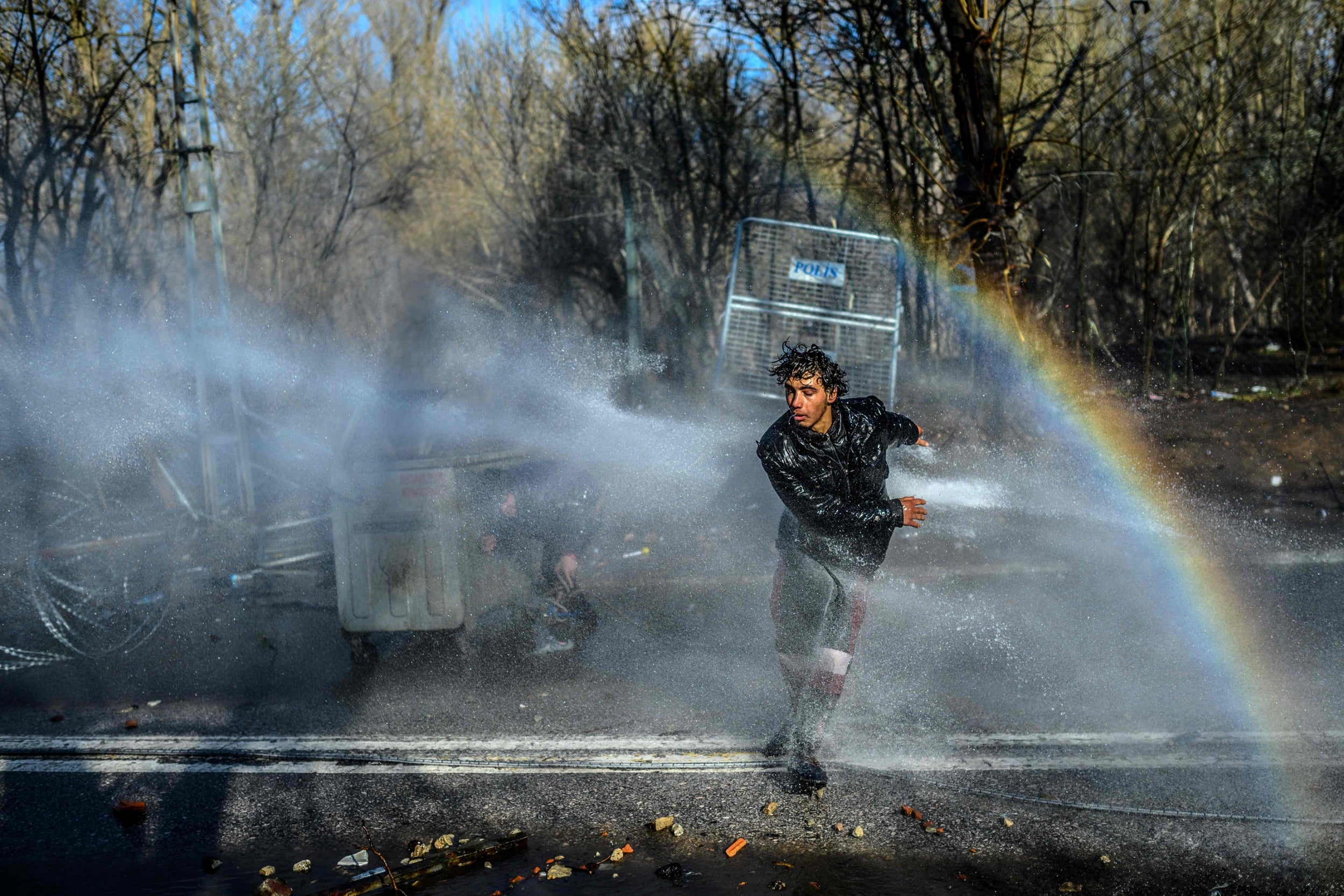
18/50 7 March 2020
A migrant man runs away as another one takes cover behind a bin as Greek police use water cannons to block them trying to break fences in the Turkey-Greece border province of Edirne
AFP/Getty

19/50 6 March 2020
Police and forensic experts inspect the scene of an explosion near the US embassy in Tunis, the capital of Tunisia
AFP/Getty
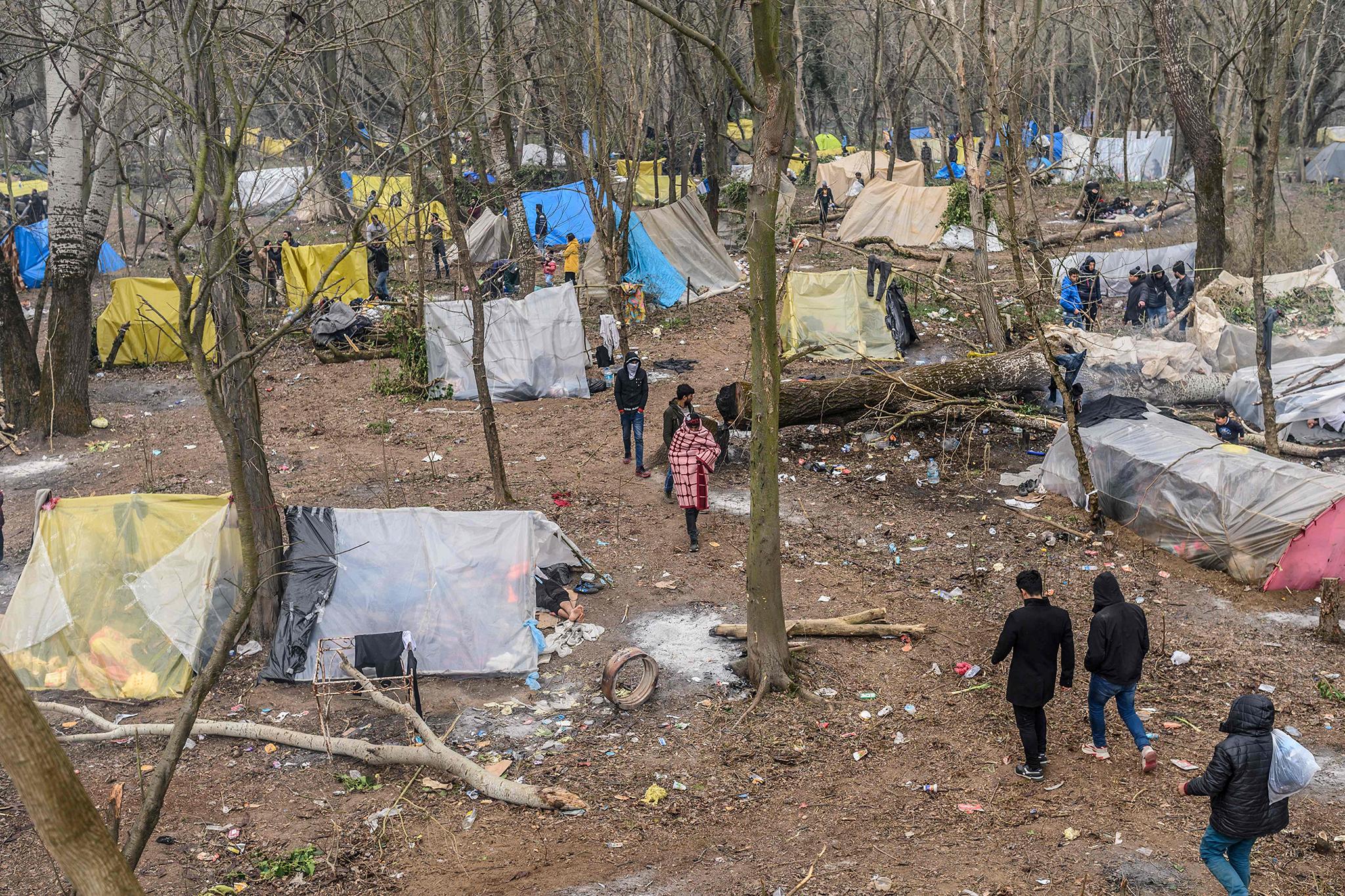
20/50 5 March 2020
Migrants prepare for the coming night in a forest in the buffer zone at the Turkey-Greece border a crossing point
AFP/Getty
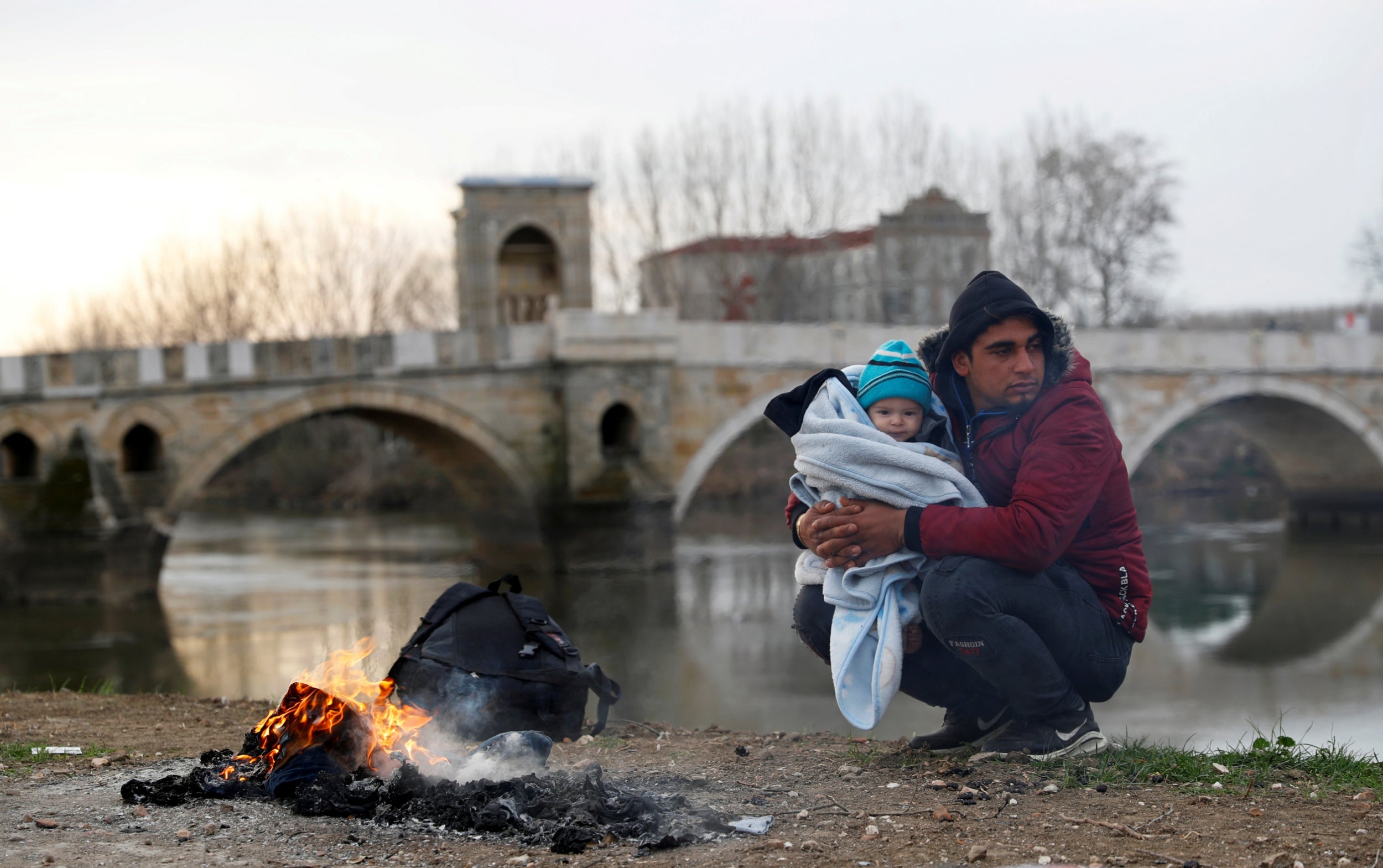
21/50 4 March 2020
A migrant rests with a child in his arms next to the Tunca river in Edirne, Turkey
Reuters

22/50 3 March 2020
Spanish policemen and civil guards sporting Guy Fawkes masks protest in front of Spanish policemen standing guard during a demonstration to demand fair wages in Madrid
AFP via Getty

23/50 2 March 2020
South Korean soldiers wearing protective gear spray disinfectant as part of preventive measures against the spread of the COVID-19 coronavirus, at a market in Daegu
Yonhap/AFP via Getty

24/50 1 March 2020
A woman shouts as law enforcement officials move in to disperse a group of immigrants who had occupied a historic church and a square. They are demanding to be moved to another country as they claim to feel not safe because of xenophobic attacks in central Cape Town, South Africa
Reuters

25/50 29 February 2020
Greek border guard use teargas to push back migrants who try to enter Greece at the Pazarkule border gate in Edirne, Turkey
AP

26/50 28 February 2020
A woman makes her way and NGO’s members help as a dinghy with 54 Afghan refugees lands ashore the Greek island of Lesbos. Turkey will no longer close its border gates to refugees who want to go to Europe, a senior official told AFP, shortly after the killing of 33 Turkish soldiers in an airstrike in northern Syria
AFP via Getty Images

27/50 27 February 2020
Snow has fallen in high ground in Tasmania during the Australian summer
Tasmanian Rover Ski Club / Facebook

28/50 26 February 2020
Men ride a motorcycle past security forces patrolling a street in a riot-affected area of Delhi on Wednesday
Reuters

29/50 25 February 2020
Workers disinfect subway trains against coronavirus in Tehran, Iran
AP

30/50 24 February 2020
Turkish-backed Syrian fighters fire their anti-aircraft gun in the town of Sarmin, about 8 kilometres southeast of the city of Idlib in northwestern Syria, as they take part in a military offensive on the village of Nayrab following an artillery barrage fired by Turkish forces
AFP via Getty
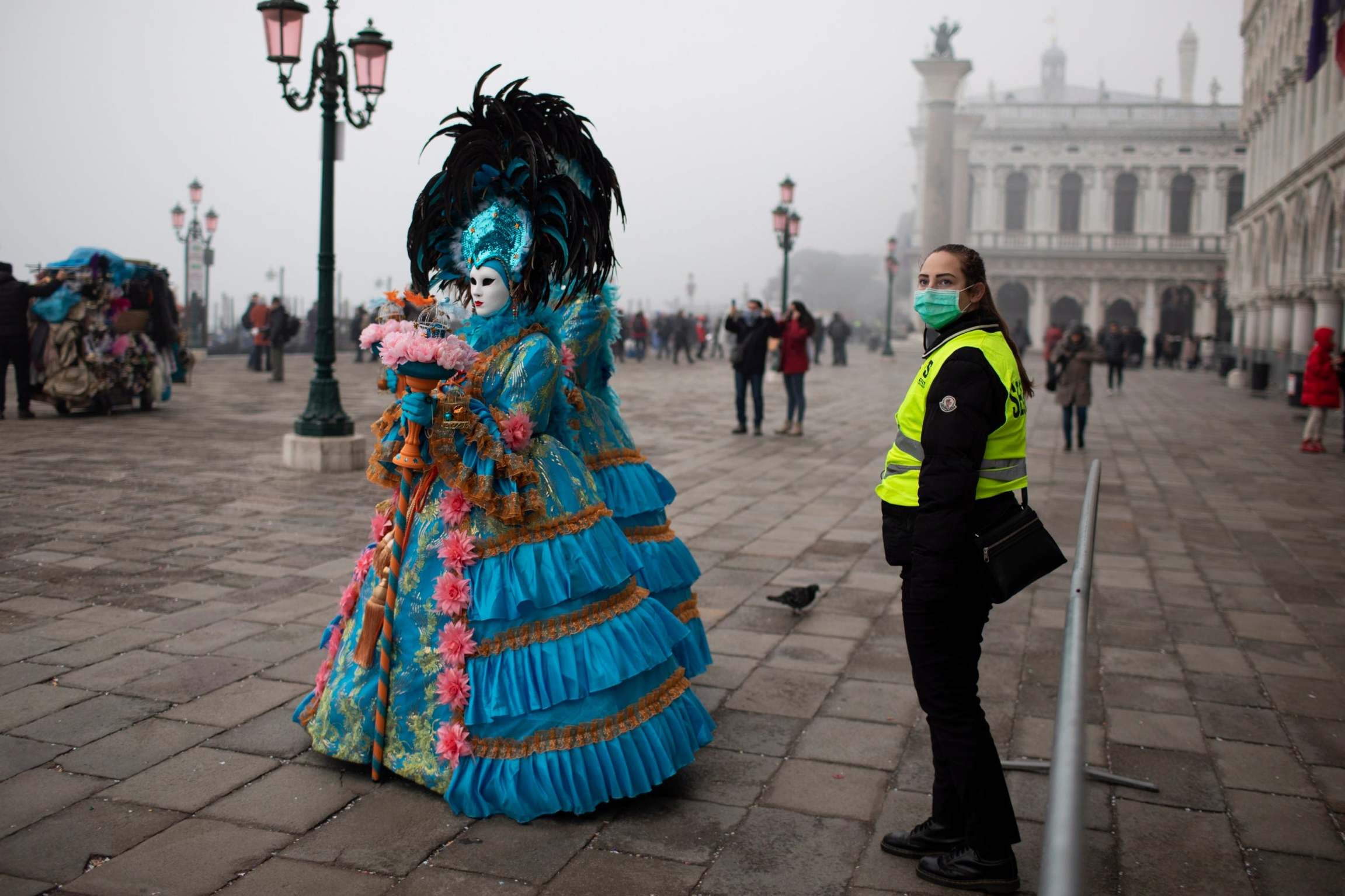
31/50 23 February 2020
A security guard wearing a protective face mask stand guard as masked and costumed people walk by during the Carnival in Venice, Italy
EPA

32/50 22 February 2020
People dressed in traditional Czech folklore costumes parade through the village of Vortova near the east Bohemian city of Pardubice during the traditional Masopust carnival. The festival marks the beginning of Lent. This folk tradition of the carnival parade of masks was registered in the UNESCO List of the Intagible Cultural Heritage of Humanity in 2010
Getty

33/50 21 February 2020
An Iranian woman wearing a face mask shows her inked finger after casting her ballot at a polling station set up at the Abdol Azim shrine during the parliamentary elections in Shahr-e-Ray, Tehran Province, Iran. Iranians are heading to the polls to elect their representatives to the Islamic Consultative Assembly amid a worsening economic crisis and escalating tensions with the US
EPA

34/50 20 February 2020
Roger Stone, former advisor to US President Donald Trump arrives at court prior to his sentencing hearing. Trump’s longtime aide will be sentenced in a case that has caused a stir in Washington following meddling by the US president and his attorney general. Stone, one of the Republican leader’s allies and “oldest friends,” was convicted in November of lying to Congress, tampering with a witness and obstructing the House investigation into whether the Trump campaign coordinated with Russia to cheat in the 2016 election
AFP via Getty

35/50 19 February 2020
Members of the Kazakh Emergencies Ministry take cover during a controlled explosion triggering an avalanche for public safety in the Tien Shan mountains outside Almaty, Kazakhstan
Reuters

36/50 18 February 2020
Women chant slogans during a demonstration against gender violence outside the National Palace, in Mexico City. Dozens of women protested over the murder of a seven-year-old girl in the Mexican capital, a case that generated anger and outrage. The murder of the minor shocked the country two days after hundreds of women protested in several cities in Mexico over the femicide of Ingrid Escamilla, a 25-year-old woman who was killed by her partner north of the Mexican capital
AFP via Getty

37/50 17 February 2020
People gather at the site of a bomb blast in Quetta, Pakistan
Reuters

38/50 16 February 2020
Dogs wearing masks are seen at a main shopping area, in downtown Shanghai, China, as the country is hit by an outbreak of a new coronavirus
REUTERS

39/50 15 February 2020
Men dressed in loincloths prepare to snatch a wooden stick called “shingi” tossed by the priest during a naked festival at Saidaiji Temple in Okayama, Okayama Prefecture Japan February 15, 2020. The person who grabs the wooden stick is considered the “luckiest man of the year”.
REUTERS

40/50 14 February 2020
Squirrels eat treats at a ‘Valentine’s day party’ organised for them by staff in Skopje Zoo, North Macedonia
Reuters
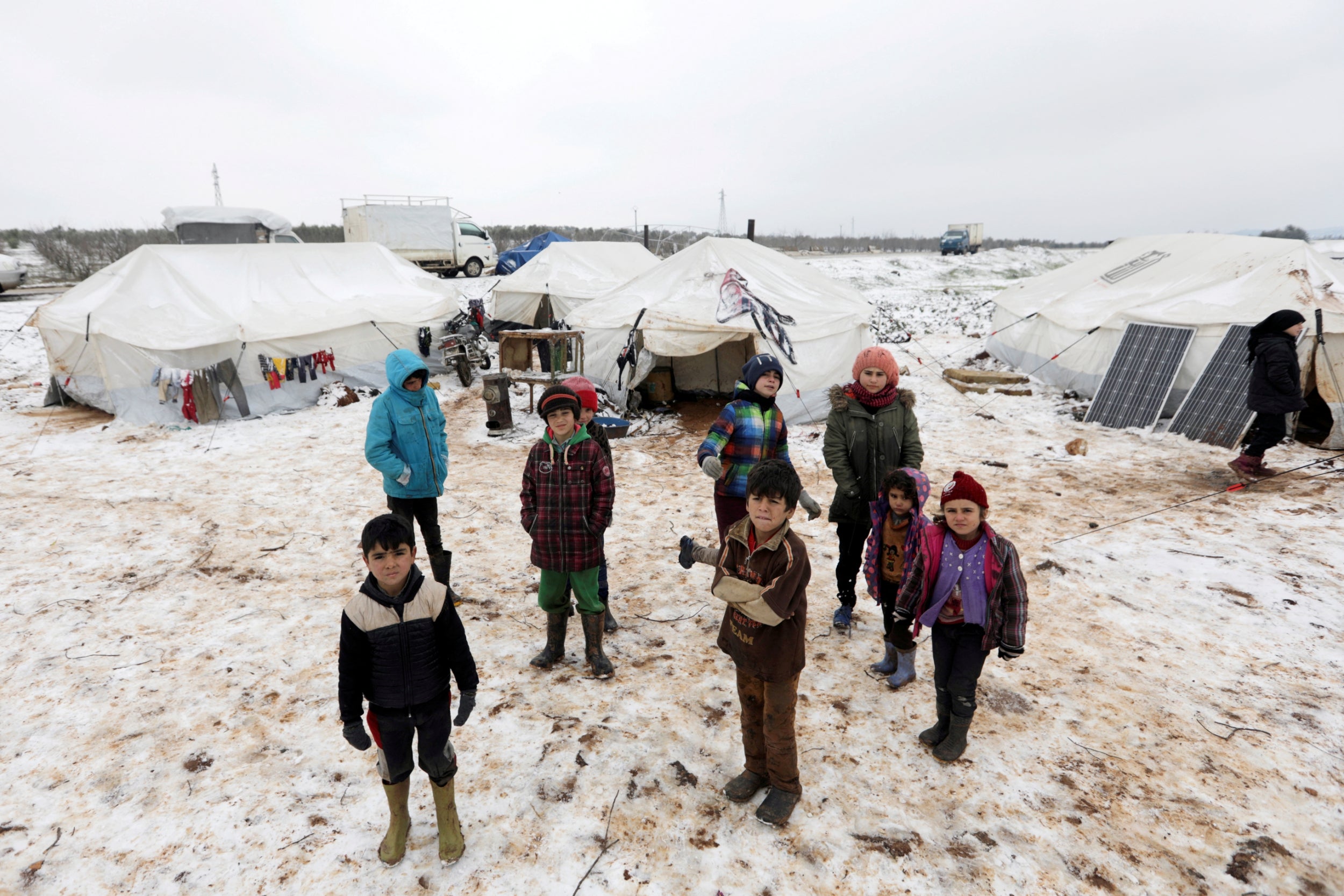
41/50 13 February 2020
Internally displaced children stand on snow near tents at a makeshift camp in Azaz, Syria
Reuters

42/50 12 February 2020
A model presents a creation from the Marc Jacobs Fall/Winter 2020 collection during New York Fashion Week
Reuters

43/50 11 February 2020
Hawaiian surfer Kai Lenny rides a wave during the big waves Nazare Tow Surfing Challenge in Nazare
AFP via Getty

44/50 10 February 2020
A worker wears a protective suit as he stands outside an office building while checking people entering in Beijing, China. The number of cases of a deadly new coronavirus rose to more than 40000 in mainland China. The country has continued to lock down the city of Wuhan in an effort to contain the spread of the pneumonia-like disease which medicals experts have confirmed can be passed from human to human. The number of those who have died from the virus in China climbed to over 900, mostly in Hubei province, and cases have been reported in other countries including the United States, Canada, Australia, Japan, South Korea, India, the United Kingdom, Germany, France and several others. The World Health Organization has warned all governments to be on alert and screening has been stepped up at airports around the world. Some countries, including the United States, have put restrictions on Chinese travellers entering and advised their citizens against travel to China
Getty

45/50 9 February 2020
South Korean film director Bong Joon Ho poses with the awards, his film Parasite, won at the Oscars. It was named best picture, becoming the first non-English language film to do so
AFP via Getty

46/50 8 February 2020
Thailand security forces take cover behind an ambulance as they chase a shooter hidden in a shopping mall after a mass shooting in front of the Terminal 21, in Nakhon Ratchasima
Reuters

47/50 7 February 2020
A Palestinian demonstrator hurls stones at Israeli forces as tires burn near the Israeli barrier during a protest against the US President Donald Trump’s Middle East peace plan, in the village of Bilin, West Bank
Reuters
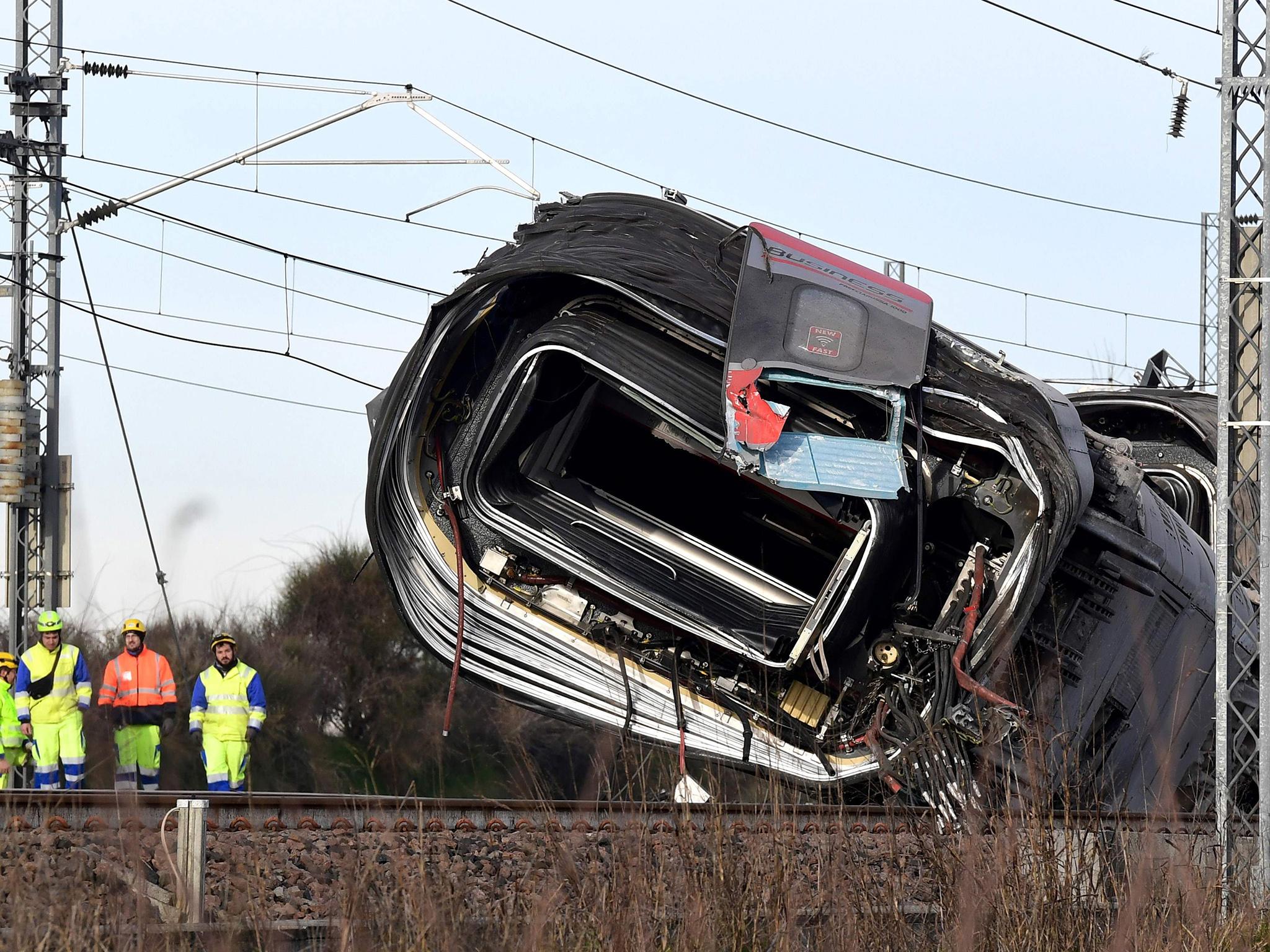
48/50 6 February 2020
Two people were killed and dozens injured when a train derailed outside the city of Lodi in Italy
AFP via Getty
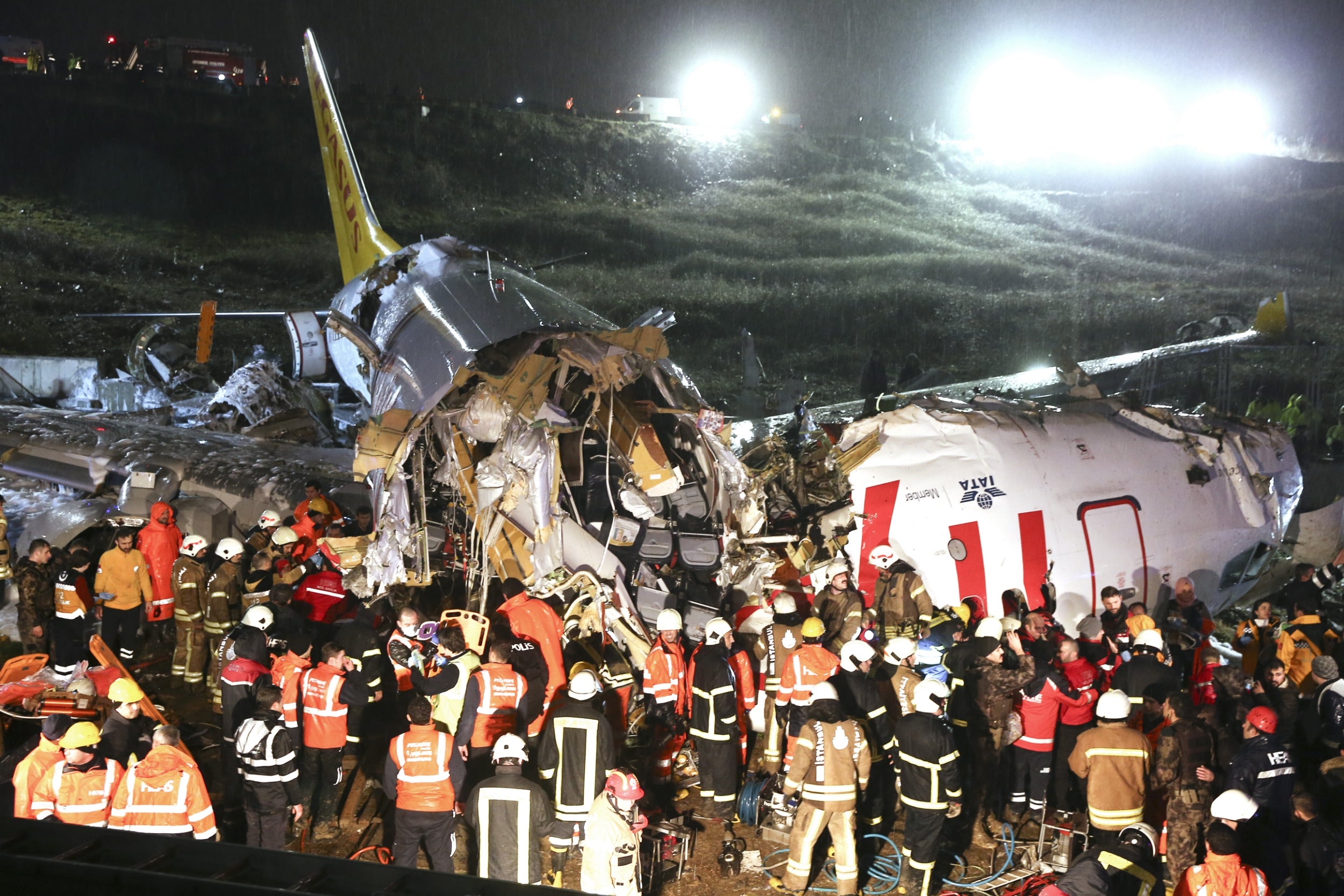
49/50 5 February 2020
Health teams and fire brigade crews surround a passenger plane which split into three pieces after it skidded off the runway at Istanbul Sabiha Gokcen International Airport in Turkey
Anadolu Agency via Getty

50/50 4 February 2020
Sri Lanka’s military march with national flags during the 72nd independence day ceremony, in Colombo
Reuters

1/50 24 March 2020
Staff members line up to attention as they prepare to spray disinfectant at Wuhan Railway Station. China announced that a lockdown would be lifted on more than 50 million people in central Hubei province where the Covid-19 coronavirus first emerged late last year
AFP via Getty

2/50 23 March 2020
A public order agency officer sprays disinfectant over a woman before she enters a local government office as a precautionary move against the spread of the Covid-19 coronavirus in Surabaya
AFP via Getty

3/50 22 March 2020
Boys wearing protective and N95 masks play with a football outside their homes in Gaza City
AFP via Getty

4/50 21 March 2020
A woman standing on her balcony reaches out to catch a rose delivered to her via a drone on Mother’s day, in the Lebanese coastal city of Jounieh, north of the capital Beirut, as people remain indoors in an effort to limit the spread of coronavirus. In a quiet Lebanese town under lockdown over the novel coronavirus, a drone buzzed towards a balcony on Saturday to deliver a red rose to a mother grinning in surprise. The COVID-19 pandemic may have put a damper on Mother’s Day this year, but three students have come up with a novel service to celebrate the occasion without flouting social distancing restrictions
AFP via Getty

5/50 20 March 2020
Newlyweds Diego Fernandes, 46 and Deni Salgado, 30, kiss through protective face masks at a wedding ceremony with only witnesses and no guests, as public gatherings are banned as part of Italy’s lockdown measures to prevent the spread of coronavirus disease in Naples
Reuters

6/50 19 March 2020
Members of a medical assistance team from Jiangsu province chant slogans at a ceremony marking their departure after helping with the Covid-19 coronavirus recovery effort, in Wuhan. Medical teams from across China began leaving Wuhan this week after the number of new coronavirus infections dropped. China on reported no new domestic cases for the first time since it started recording them in January, but recorded a spike in infections from abroad
AFP via Getty

7/50 18 March 2020
Sri Lankan police wear face masks a rehearsal parade in Colombo
AFP via Getty

8/50 17 March 2020
Divers clean and swipe the floor and walls of a pool at an aquatic complex in Medellin after the closure of all sporting venues in Colombia as a preventive measure against the spread of the Covid-19
AFP via Getty

9/50 16 March 2020
Workers spray disinfectant as a precaution against the spread of coronavirus at the Mubarikiya market following the outbreak of coronavirus, in Kuwait City
EPA

10/50 15 March 2020
People gather with their belongings at the scene of the fire outbreak at Abule-Ado in Lagos, Nigeria
Reuters

11/50 14 March 2020
A man feeds pidgeons at Cataluna Square in Barcelona
EPA

12/50 13 March 2020
A mosso de esquadra police officer stands on the closed off road near Igualada, Spain. Over 60,000 people awoke Friday in four towns near Barcelona confined to their homes and with police blocking roads. The order by regional authorities in Catalonia is Spain’s first mandatory lockdown as Covid-19 coronavirus infections increase sharply
AP

13/50 12 March 2020
Italian mechanics Giacomo and Alessandro pose at their garage in Rome, as Italy shut all stores except for pharmacies and food shops in a desperate bid to halt the spread of a coronavirus that has killed 827 in the the country in just over two weeks
AFP via Getty

14/50 11 March 2020
Monks pray for victims of the 2011 earthquake and tsunami disaster during a memorial service on the coast in Iwaki, Fukushima. Japan marked the ninth anniversary of the killer tsunami that triggered the Fukushima nuclear meltdown, but fears about the new coronavirus forced a scaling back of public commemorations
Jiji Press/AFP via Getty

15/50 10 March 2020
Revellers dance as they celebrate Holi, the spring festival of colours in Allahabad
AFP/Getty

16/50 9 March 2020
Medical staff celebrate after all patients were discharged at a temporary hospital set up to treat people with the COVID-19 coronavirus in Wuhan in China
AFP/Getty

17/50 8 March 2020
A hundred members of the conservative activist group called Manif pour Tous (“Protest for Everyone”) dressed as Marianne, French Republic’s allegory, stage a protest against assisted reproductive technology (ART) and surrogacy in front of the National Assembly in Paris, France
AFP/Getty

18/50 7 March 2020
A migrant man runs away as another one takes cover behind a bin as Greek police use water cannons to block them trying to break fences in the Turkey-Greece border province of Edirne
AFP/Getty

19/50 6 March 2020
Police and forensic experts inspect the scene of an explosion near the US embassy in Tunis, the capital of Tunisia
AFP/Getty

20/50 5 March 2020
Migrants prepare for the coming night in a forest in the buffer zone at the Turkey-Greece border a crossing point
AFP/Getty

21/50 4 March 2020
A migrant rests with a child in his arms next to the Tunca river in Edirne, Turkey
Reuters

22/50 3 March 2020
Spanish policemen and civil guards sporting Guy Fawkes masks protest in front of Spanish policemen standing guard during a demonstration to demand fair wages in Madrid
AFP via Getty

23/50 2 March 2020
South Korean soldiers wearing protective gear spray disinfectant as part of preventive measures against the spread of the COVID-19 coronavirus, at a market in Daegu
Yonhap/AFP via Getty

24/50 1 March 2020
A woman shouts as law enforcement officials move in to disperse a group of immigrants who had occupied a historic church and a square. They are demanding to be moved to another country as they claim to feel not safe because of xenophobic attacks in central Cape Town, South Africa
Reuters

25/50 29 February 2020
Greek border guard use teargas to push back migrants who try to enter Greece at the Pazarkule border gate in Edirne, Turkey
AP

26/50 28 February 2020
A woman makes her way and NGO’s members help as a dinghy with 54 Afghan refugees lands ashore the Greek island of Lesbos. Turkey will no longer close its border gates to refugees who want to go to Europe, a senior official told AFP, shortly after the killing of 33 Turkish soldiers in an airstrike in northern Syria
AFP via Getty Images

27/50 27 February 2020
Snow has fallen in high ground in Tasmania during the Australian summer
Tasmanian Rover Ski Club / Facebook

28/50 26 February 2020
Men ride a motorcycle past security forces patrolling a street in a riot-affected area of Delhi on Wednesday
Reuters

29/50 25 February 2020
Workers disinfect subway trains against coronavirus in Tehran, Iran
AP

30/50 24 February 2020
Turkish-backed Syrian fighters fire their anti-aircraft gun in the town of Sarmin, about 8 kilometres southeast of the city of Idlib in northwestern Syria, as they take part in a military offensive on the village of Nayrab following an artillery barrage fired by Turkish forces
AFP via Getty

31/50 23 February 2020
A security guard wearing a protective face mask stand guard as masked and costumed people walk by during the Carnival in Venice, Italy
EPA

32/50 22 February 2020
People dressed in traditional Czech folklore costumes parade through the village of Vortova near the east Bohemian city of Pardubice during the traditional Masopust carnival. The festival marks the beginning of Lent. This folk tradition of the carnival parade of masks was registered in the UNESCO List of the Intagible Cultural Heritage of Humanity in 2010
Getty

33/50 21 February 2020
An Iranian woman wearing a face mask shows her inked finger after casting her ballot at a polling station set up at the Abdol Azim shrine during the parliamentary elections in Shahr-e-Ray, Tehran Province, Iran. Iranians are heading to the polls to elect their representatives to the Islamic Consultative Assembly amid a worsening economic crisis and escalating tensions with the US
EPA

34/50 20 February 2020
Roger Stone, former advisor to US President Donald Trump arrives at court prior to his sentencing hearing. Trump’s longtime aide will be sentenced in a case that has caused a stir in Washington following meddling by the US president and his attorney general. Stone, one of the Republican leader’s allies and “oldest friends,” was convicted in November of lying to Congress, tampering with a witness and obstructing the House investigation into whether the Trump campaign coordinated with Russia to cheat in the 2016 election
AFP via Getty

35/50 19 February 2020
Members of the Kazakh Emergencies Ministry take cover during a controlled explosion triggering an avalanche for public safety in the Tien Shan mountains outside Almaty, Kazakhstan
Reuters

36/50 18 February 2020
Women chant slogans during a demonstration against gender violence outside the National Palace, in Mexico City. Dozens of women protested over the murder of a seven-year-old girl in the Mexican capital, a case that generated anger and outrage. The murder of the minor shocked the country two days after hundreds of women protested in several cities in Mexico over the femicide of Ingrid Escamilla, a 25-year-old woman who was killed by her partner north of the Mexican capital
AFP via Getty

37/50 17 February 2020
People gather at the site of a bomb blast in Quetta, Pakistan
Reuters

38/50 16 February 2020
Dogs wearing masks are seen at a main shopping area, in downtown Shanghai, China, as the country is hit by an outbreak of a new coronavirus
REUTERS

39/50 15 February 2020
Men dressed in loincloths prepare to snatch a wooden stick called “shingi” tossed by the priest during a naked festival at Saidaiji Temple in Okayama, Okayama Prefecture Japan February 15, 2020. The person who grabs the wooden stick is considered the “luckiest man of the year”.
REUTERS

40/50 14 February 2020
Squirrels eat treats at a ‘Valentine’s day party’ organised for them by staff in Skopje Zoo, North Macedonia
Reuters

41/50 13 February 2020
Internally displaced children stand on snow near tents at a makeshift camp in Azaz, Syria
Reuters

42/50 12 February 2020
A model presents a creation from the Marc Jacobs Fall/Winter 2020 collection during New York Fashion Week
Reuters

43/50 11 February 2020
Hawaiian surfer Kai Lenny rides a wave during the big waves Nazare Tow Surfing Challenge in Nazare
AFP via Getty

44/50 10 February 2020
A worker wears a protective suit as he stands outside an office building while checking people entering in Beijing, China. The number of cases of a deadly new coronavirus rose to more than 40000 in mainland China. The country has continued to lock down the city of Wuhan in an effort to contain the spread of the pneumonia-like disease which medicals experts have confirmed can be passed from human to human. The number of those who have died from the virus in China climbed to over 900, mostly in Hubei province, and cases have been reported in other countries including the United States, Canada, Australia, Japan, South Korea, India, the United Kingdom, Germany, France and several others. The World Health Organization has warned all governments to be on alert and screening has been stepped up at airports around the world. Some countries, including the United States, have put restrictions on Chinese travellers entering and advised their citizens against travel to China
Getty

45/50 9 February 2020
South Korean film director Bong Joon Ho poses with the awards, his film Parasite, won at the Oscars. It was named best picture, becoming the first non-English language film to do so
AFP via Getty

46/50 8 February 2020
Thailand security forces take cover behind an ambulance as they chase a shooter hidden in a shopping mall after a mass shooting in front of the Terminal 21, in Nakhon Ratchasima
Reuters

47/50 7 February 2020
A Palestinian demonstrator hurls stones at Israeli forces as tires burn near the Israeli barrier during a protest against the US President Donald Trump’s Middle East peace plan, in the village of Bilin, West Bank
Reuters

48/50 6 February 2020
Two people were killed and dozens injured when a train derailed outside the city of Lodi in Italy
AFP via Getty

49/50 5 February 2020
Health teams and fire brigade crews surround a passenger plane which split into three pieces after it skidded off the runway at Istanbul Sabiha Gokcen International Airport in Turkey
Anadolu Agency via Getty

50/50 4 February 2020
Sri Lanka’s military march with national flags during the 72nd independence day ceremony, in Colombo
Reuters
They warned: “These measures risk having a serious impact on the functioning of the single market as the EU and the Schengen area is characterised by a high degree of integration, with millions of people crossing internal borders every day.”
So far, the external travel ban seems to have done little to open the internal borders, with over a dozen different countries formally notifying of restrictions. Supporters of free movement – and those crossing borders regularly – will hope that when the pandemic finally abates, countries have not got a taste for passport checks.



